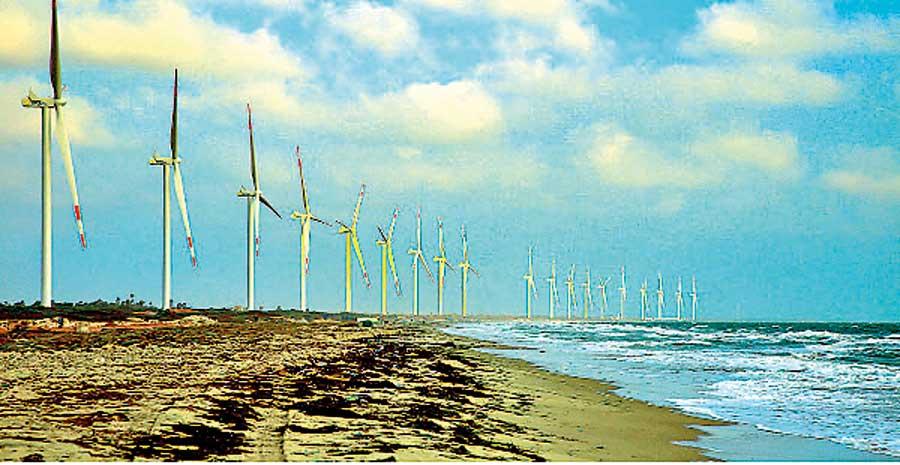04 Jul 2022 - {{hitsCtrl.values.hits}}

WIND POWER PROJECT it says Wind project
Energy is a vital factor for any country’s economy and in Sri Lanka there is much public focus on the subject because of the power cuts the people are experiencing every day. The power cuts have an impact on every home, people’s life style and children’s education, especially in the post-COVID environment where many are learning online.
cuts have an impact on every home, people’s life style and children’s education, especially in the post-COVID environment where many are learning online.
On the economic front it affects all businesses while its impact on production is severe because factories and their supply lines are affected in many ways. Here I am talking mostly on the supply side of energy. Energy must be available continuously for people to maintain their living standards as well as for country’s economic progress.
Then the other important thing about energy is basically it has to be environment friendly. From time to time there have been many global discussions and agreements on the subject such as Earth Summit and Tokyo Declaration which talks about the carbon footprint.
They focused on reducing global warming in different ways, but my main emphasis here is environmental impact of energy and pricing because it needs to be affordable. Lower energy costs also make a country’s manufacturing industries competitive. Sri Lanka’s energy costs have been high and that is why we are not very competitive in the industrial sector.
"By about 1996, Sri Lanka fulfilled its energy requirements with nearly 100% renewable energy. Over a period of time we have moved away from that and now we are heavily dependent on thermal energy as well. Now the main sources of energy are our major hydros, renewable, liquid fuel and coal"
Need for renewable energy
By about 1996, Sri Lanka fulfilled its energy requirements with nearly 100% renewable energy. Over a period of time we have moved away from that and now we are heavily dependent on thermal energy as well. Now the main sources of energy are our major hydros, renewable, liquid fuel and coal.
If we look at the production of our energy major hydros give about 25-30%, renewable is about 15%, coal is about 25-30% and the balance is from liquid fuel. Main point here is major hydros and renewable sources produce 50% or below while the majority 50-55% is thermal which is coal and liquid fuel. So that is not satisfactory both on cost side and in terms of protecting our environment.
On the cost side there are huge variations in the cost of a unit kilo watt hour. In hydro it is about Rs. 7 or 8 a unit, renewable is between Rs. 15 to 20 per unit, coal is about Rs. 50 and if you take liquid fuel it is about Rs. 100 or more so that you can see the huge price differential.
Significance of energy policy
That is one of the big issues facing Sri Lanka and the country needs an energy policy as well as an energy generation plan. The energy policy must be driven by the government and unfortunately in our country some people seem to think that Ceylon Electricity Board (CEB) should decide the energy policy.
Government decides the energy policy and CEB has to prepare the long-term energy generation plan to suit that policy. In doing so government has to take into account economic reasons but unfortunately some sidetrack arguing that whole energy policy has to be driven technically.
Technical limitations are surely there, for example there is so much of hydro power that you can actually produce; you cannot produce more than what the nature has given you. But then the government has to decide how much is going to be thermal and how much is sustainable energy.
The incumbent President made a pronouncement that when he gets elected he would have 70% sustainable energy and he gave a time frame for it to be achieved. The long-term generation plan is normally done by the CEB for 20 years. Accordingly, they did the 2022-2041 energy plan limiting sustainable energy to 50%.
The plan was submitted to the Public Utilities Commission of Sri Lanka (PUCSL) but they did not approve it because it was not in keeping with the government stipulated policy. The PUCSL has asked the CEB to re-produce an amended plan by June 30, 2022. In the plan they have not spoken about increasing coal power, but they talk about increasing the use of gas.
"That is one of the big issues facing Sri Lanka and the country needs an energy policy as well as an energy generation plan. The energy policy must be driven by the government and unfortunately in our country some people seem to think that Ceylon Electricity Board (CEB) should decide the energy policy. "
Battle between CEB and sustainable energy authority
Apart from the CEB and the PUCSL there is Sri Lanka Sustainable Energy Authority and they had approved about 1374 sustainable energy projects giving them licenses to proceed. These 1374 projects were to generate about 4000 megawatts. However, these projects were stalled because the CEB refused to give them power purchasing agreements. The country has suffered as a result of the battle between these two entities.
Under the law there is provision for government to government projects, where there is an offer from a foreign sovereign government to the government of Sri Lanka for which approval of the cabinet of ministers has been obtained. In a recent project, Indian company Adani Group wanted to do a wind power project in Mannar. The question there was whether it was a government to government one and the other issue was how the pricing was to be determined.
Whichever the project we have to look at it from the consumers’ point which means it has to be at the lowest possible price. If it is an open tender, then it is clear how the price is determined. If it is through feeder tariff scheme it also has a method to determine the price. It gets complicated when it is a large project and if there is no tender. That is an issue that needs to be sorted out.
My focus here is not the Adani project, but I wish to make the larger point why we need renewable energy and why it needs to be at low cost. If there are large projects, they need to be ideally tendered out so there is transparency, competition and the consumer gets the best deal.
Then I am also making the point that the CEB has to come up with a power generation plan which is in keeping with the government policy. CEB is a monopoly and therefore we need to have multiple buyers. We have many producers, but we only have a single buyer. That is why even though sustainable energy authority gave licenses for people to produce energy they could not go ahead with it because they need to sign a power purchasing agreement with the CEB which is a monopoly. Clearly from the consumers’ point of view we have to question that.
"The other issue that has come up recently in the public domain is why emergency power purchases are often resorted to. There are also allegations that water levels in the reservoirs are reduced and then emergency power is procured"
Need for multi buyer models
Now there is a need for multi-buyer models as well particularly in buying corporate clean energy. The purchaser should have the option to buy from any one while the seller also should have the option to sell to anyone.
Today, there are sophisticated product buyers who want to see whether the producers are using clean energy. Twenty years ago, they were checking whether factories producing the garments were using child labour. Now it has moved to another stage where they want to know what kind of energy was used whether it was clean energy or energy creating global warming.
So, the factories using clean energy will have the advantage because some of the buyers may stipulate what kind of energy use they prefer. So, there are multi buyer models all over the world and we also need to open ourselves to looking at that and opening it out.
Then the other issue that has come up recently in the public domain is why emergency power purchases are often resorted to. There are also allegations that water levels in the reservoirs are reduced and then emergency power is procured.
People have serious doubts because politicians and public officials at higher levels are probably corrupt. An independent audit needs to be done over these allegations. CEB’s promises to conduct internal audits will not be good enough and we need external parties to confirm that as well.
Some of the regulatory functions originally vested with the CEB have been later placed under the PUCSL by subsequent legislation such as Sri Lanka Electricity Act while Sri Lanka Sustainable Energy Authority also has been given certain powers. PUCSL has the authority to act as the economic, technical and safety regulator for the electricity industry in Sri Lanka. The provisions of these laws need to be properly adhered to ensure a proper energy mix for Sri Lanka and an efficient energy administration.
The author is a former VP, Citibank and Director/CEO, National Development Bank
27 Nov 2024 25 minute ago
27 Nov 2024 35 minute ago
27 Nov 2024 39 minute ago
27 Nov 2024 57 minute ago
27 Nov 2024 2 hours ago